Setting of Gems & Diamonds in Jewellery
Jewellery that uses gemstones and diamonds need a skilled setter to be able to place each gem in the precious metal with absolute accuracy. Rings could have a Diamond set in a way in which the stones appear to be floating in the gold like the Flush Setting or perhaps Emeralds that are secured in a pendant with prongs that grip the stone from its corners like in the Prong Setting. Setting plays an important role in what the jewellery piece finally looks like. It is the process by which gemstones are secured in place within the metal. Setters are skilled workers who set each gemstone with precision and have to be very gentle as they can damage stones and the metal if extra pressure is exerted with the tools.
THE PROCESS:
When done by hand the cleaned jewellery piece in its raw unfinished state is placed onto a “chapdi” wherein the setter can gently set each gemstone with absolute accuracy. The chapdi uses lac to grip the metal and secure it in place. The setter places each gemstone in the metal collet and then carefully adopts the preferred setting style to set each gemstone.
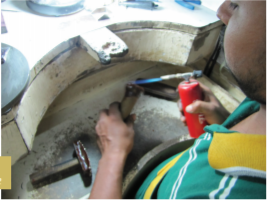
The setter preparing the chapdi with the lac for the jewellery piece
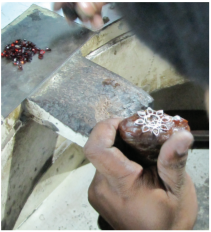
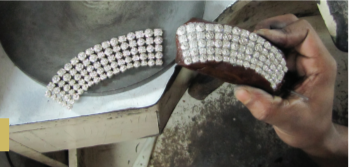
The jewellery in the lac and a finished piece to its left
The setter carefully placing each gem with absolute accuracy Finished pieces as mentioned depend immensely on the talent of each worker. The setting being a very important part of the whole process, skilled workers command a premium. This is the reason why branded jewellery players like KuberBox can provide you with a great quality product by employing highly trained and skilled workers for each process. Local jewellers, on the other hand, do not have the necessary tools and tech and are known to cut corners during manufacturing. This lack eventually shows in their jewellery’s finishing.
Here are some of the different types of setting styles:
PAVÉ SETTING The Pavé Setting has gems set in a way that they appear to be in a honeycomb. Much skill is required in this setting, as the setter must be ever so delicate with each stone that he places into the metal. The close proximity of each stone makes it all the more difficult when trying to set each one faultlessly.
CHANNEL SETTING Channel setting as the name suggests uses channels where stones are placed side-by-side and secured. Channel setting can be sturdier when there are metal bars on the bottom reducing the risk of stones becoming loose and undone in their setting. This setting style holds the gems in position clasping from the edges.
BEZEL SETTING In the Bezel setting, a thin strip of metal wraps the gem and secures it in place. This thin piece of metal is called a bezel. The bezel setting is a popular setting style these days as it gives the jewellery the impression that each gemstone has a gold boundary. It is very attractive and gives the jewels an expensive look.
PRONG SETTING Thin wires of the metal called Prongs usually in pairs of two hold the gems in place. It can also be called claws or the claw setting, as they tend to resemble claws holding the gem securely in position. Prong settings must be used very carefully especially when used with diamonds, as diamonds are so much harder than the noble metals that it can wear away the prongs over time. But that’s rarity.
FLUSH SETTING The flush setting uses the entire metal to protect the stones and hold them in place. Each stone appears to be within the jewellery piece and is still very secure. Flush setting is commonly seen in rings, on bands on bangles etc.
PRESSURE SETTING Pressure setting is where gems are placed so closely together, that it’s impossible to tell they are secured by metal. Pressure setting requires the stones to be grooved under the table where they can slide into position and then are supported by a wire from within. One of the most difficult techniques to master, it takes a lot of precise effort. In the invisible setting, the stones appear to be holding each other in place. Pressure setting is popularly used as a replacement for solitaire diamonds. This is because the stones are put so close to each other, they almost start appearing as a solitaire. It is sometimes also called a precious setting.
TENSION SETTING Today a commonly seen setting style is the tension setting, where the metal acts like a spring, holding the gem in place. Gems look as if they are floating but it also tends to attract a lot more dirt and grease as compared to the other setting styles, primarily because the stone is completely exposed in this setting. There are many other setting styles, some trademark setting styles and some outdated styles that people use. The ones that we have mentioned above are some of the most popular and commonly used styles.
FAQ:
- Which diamond setting is best?
The most classic among these is called the prong setting. It is also the most popular as the stone is held in place with a minimal amount of metal, usually four or six prongs, allowing more light to pass through the diamond resulting in added brilliance.
2. What setting makes diamond look bigger?
If you select a setting with a slim band and slim prongs, your center diamond will look larger in comparison. On the other hand, if you choose a wide band with bulky prongs, your diamond will look smaller.
Setting of Gems & Diamonds in Jewellery by Team KuberBox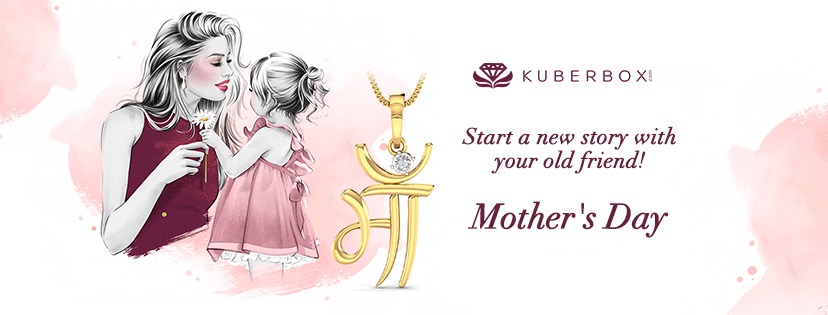
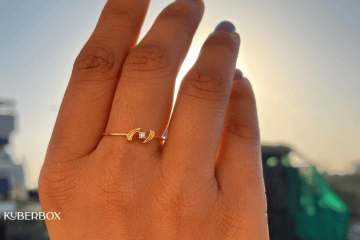

0 Comments